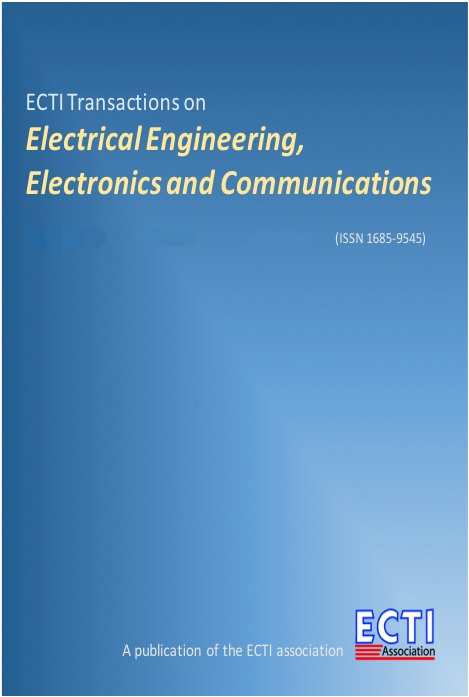Associated Sectors of Magnetic Recording Systems Using Spatially Coupled LDPC Codes
Main Article Content
Abstract
In traditional magnetic recording systems, non-associated sectors are mainly adopted, whereby two consecutive sectors are decoded independently by the low-density parity-check (LDPC) codes. In this paper, we propose a magnetic recording system with associated sectors, constructed using spatially coupled low-density parity-check (SC-LDPC) codes. If the SC-LDPC decoder cannot correct the erroneous bits in the current sector, it can request information stored in previous sectors to improve decoding performance. Moreover, we modify protograph-based extrinsic information transfer (P-EXIT) charts to examine the theoretical performance of SC-LDPC codes applied to both non-associated and associated sectors. Our theoretical results show that the associated sectors achieve significant performance gains compared to the traditional non-associated sectors.
Article Details

This work is licensed under a Creative Commons Attribution-NonCommercial-NoDerivatives 4.0 International License.
This journal provides immediate open access to its content on the principle that making research freely available to the public supports a greater global exchange of knowledge.
- Creative Commons Copyright License
The journal allows readers to download and share all published articles as long as they properly cite such articles; however, they cannot change them or use them commercially. This is classified as CC BY-NC-ND for the creative commons license.
- Retention of Copyright and Publishing Rights
The journal allows the authors of the published articles to hold copyrights and publishing rights without restrictions.
References
A. Jimenez Felstrom and K. S. Zigangirov, “Time-varying periodic convolutional codes with low-density parity-check matrix,” IEEE Transactions on Information Theory, vol. 45, no. 6, pp. 2181–2191, Sep. 1999.
M. Lentmaier, A. Sridharan, D. J. Costello, and K. S. Zigangirov, “Iterative decoding threshold analysis for LDPC convolutional codes,” IEEE Transactions on Information Theory, vol. 56, no. 10, pp. 5274–5289, Oct. 2010.
S. Kudekar, T. J. Richardson, and R. L. Urbanke, “Threshold saturation via spatial coupling: why convolutional LDPC ensembles perform so well over the BEC,” IEEE Transactions on Information Theory, vol. 57, no. 2, pp. 803–834, Feb. 2011.
A. R. Iyengar, M. Papaleo, P. H. Siegel, J. K. Wolf, A. Vanelli-Coralli, and G. E. Corazza, “Windowed decoding of protograph-based LDPC convolutional codes over erasure channels,” IEEE Transactions on Information Theory, vol. 58, no. 4, pp. 2303–2320, Apr. 2012.
A. R. Iyengar, P. H. Siegel, R. L. Urbanke, and J. K. Wolf, “Windowed decoding of spatially coupled codes,” IEEE Transactions on Information Theory, vol. 59, no. 4, pp. 2277–2292, Apr. 2013.
H. Esfahanizadeh, A. Hareedy, and L. Dolecek, “Spatially coupled codes optimized for magnetic recording applications,” IEEE Transactions on Magnetics, vol. 53, no. 2, Feb. 2017, Art. no. 3100211.
Z. Yang, Y. Fang, G. Zhang, G. Han, and L. Kong, “Performance analysis and optimization of spatially coupled protograph-based low-density parity-check codes for two-dimensional magnetic recording systems,” IEEE Transactions on Magnetics, vol. 56, no. 3, Mar. 2020, Art. no. 6701807.
S. Khittiwitchayakul, W. Phakphisut, and P. Supnithi, “Reduced complexity window decoding of spatially coupled LDPC codes for magnetic recording systems,” IEEE Transactions on Magnetics, vol. 54, no. 11, Nov. 2018, Art. no. 9401205.
H. Esfahanizadeh, A. Hareedy, R. Wu, R. Galbraith, and L. Dolecek, “Spatially-coupled codes for channels with SNR variation,” IEEE Transactions on Magnetics, vol. 54, no. 11, Nov. 2018, Art. no. 9401505.
G. Liva and M. Chiani, “Protograph LDPC codes design based on EXIT analysis,” in IEEE GLOBECOM 2007 - IEEE Global Telecommunications Conference, Washington, DC, USA, 2007, pp. 3250–3254.
S. Khittiwitchayakul, P. Supnithi, and W. Phakphisut, “Associated sectors of magnetic recording system via spatially coupled LDPC codes,” in 2021 18th International Conference on Electrical Engineering/Electronics, Computer, Telecommunications and Information Technology (ECTI-CON), 2021, pp. 612–615.
J. Thorpe, “Low-density parity-check (LDPC) codes constructed from protographs,” The Interplanetary Network Progress Report, vol. 42-154, pp. 1–7, Aug. 2003. [Online]. Available: https://ipnpr.jpl.nasa.gov/progress_report/42-154/154C.pdf
D. G. M. Mitchell, M. Lentmaier, and D. J. Costello, “Spatially coupled LDPC codes constructed from protographs,” IEEE Transactions on Information Theory, vol. 61, no. 9, pp. 4866–4889, Sep. 2015.
H.-Y. Kwak, D.-Y. Yun, and J.-S. No, “Rate-loss mitigation of SC-LDPC codes without performance degradation,” IEEE Transactions on Communications, vol. 68, no. 1, pp. 55–65, Jan. 2020.
S. Nabavi, B. V. K. V. Kumar, and J. A. Bain, “Two-dimensional pulse response and media noise modeling for bit-patterned media,” IEEE Transactions on Magnetics, vol. 44, no. 11, pp. 3789–3792, Nov. 2008.
T. Sopon, P. Supnithi, and K. Vichienchom, “Improved 2-D graph-based detectors for 2-D interference channels,” IEEE Transactions on Magnetics, vol. 50, no. 11, Nov. 2014, Art. no. 3101704.
T. Sopon, L. M. M. Myint, P. Supnithi, and K. Vichienchom, “Modified graph-based detection methods for two-dimensional interference channels,” IEEE Transactions on Magnetics, vol. 48, no. 11, pp. 4618–4621, Nov. 2012.
S. Nabavi and B. V. K. V. Kumar, “Two-dimensional generalized partial response equalizer for bitpatterned media,” in 2007 IEEE International Conference on Communications (ICC), 2007, pp. 6249–6254.
W. E. Ryan and S. Lin, Channel codes: classical and modern. Cambridge, UK: Cambridge University Press, 2009.
T. V. Nguyen, A. Nosratinia, and D. Divsalar, “Protograph-based LDPC codes for partial response channels,” in 2012 IEEE International Conference on Communications (ICC), 2012, pp. 2166–2170.
S. ten Brink, G. Kramer, and A. Ashikhmin, “Design of low-density parity-check codes for modulation and detection,” IEEE Transactions on Communications, vol. 52, no. 4, pp. 670–678, Apr. 2004.
X.-Y. Hu, E. Eleftheriou, and D. M. Arnold, “Regular and irregular progressive edge-growth tanner graphs,” IEEE Transactions on Information Theory, vol. 51, no. 1, pp. 386–398, Jan. 2005.
P. Kang, Y. Xie, L. Yang, and J. Yuan, “Reliability-based windowed decoding for spatially coupled LDPC codes,” IEEE Communications Letters, vol. 22, no. 7, pp. 1322–1325, Jul. 2018.
M. Lentmaier, M. M. Prenda, and G. P. Fettweis, “Efficient message passing scheduling for terminated LDPC convolutional codes,” in 2011 IEEE International Symposium on Information Theory, 2011, pp. 1826–1830.

